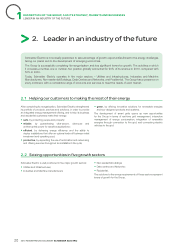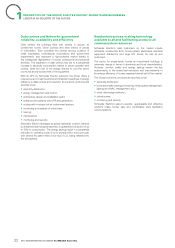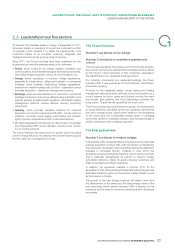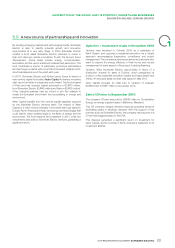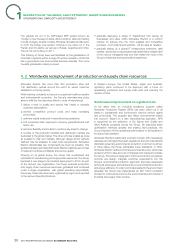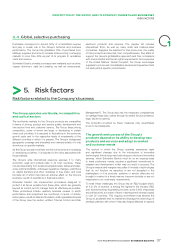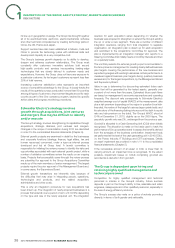APC 2010 Annual Report Download - page 32
Download and view the complete annual report
Please find page 32 of the 2010 APC annual report below. You can navigate through the pages in the report by either clicking on the pages listed below, or by using the keyword search tool below to find specific information within the annual report.
DESCRIPTION OFTHEGROUP, ANDITSSTRATEGY, MARKETS ANDBUSINESSES
1INNOVATION AND R&D: SERVINGGROWTH
partnerships with potential game-changing players in Asia-Pacifi c,
North America or Europe.
In the framework of the global program for the recognition of
experts, 300 employees from 19 countries which are representative
of the Group’s R&D were identifi ed. They play an important role
in Schneider Electric’s innovation process. Led by the Human
Resources Department, the Innovation Department and the main
R&D managers, this program aims to promote the development of
experts at a high level, as well as their contribution to the defi nition
and implementation of the R&D strategy. All these experts are
included in formal networks aligned with the skills areas critical to
the Group’s long-term success.
In an increasingly competitive global environment, the protection of
intellectual property is a particular priority for this network of experts.
In all, 386 patents were fi led in 2010, an increase of almost 20%
on 2009; the number of patents fi led has doubled in the space of
four years.
3. 3 Projects focused on energy efficiency and customer values
To respond to the global and local challenges of energy management,
Schneider Electric has set up a research, development and
innovation program centered on (i) designing energy effi ciency
solutions tailored to each market (buildings, residential, industry,
data centres) and (ii) improving the way in which customer
requirements are met in terms of interoperability, ergonomics, safe
operation, and respect for the environment.
The implementation of tomorrow’s energy effi ciency solutions
implies a more advanced capacity to install sensors and actuators
depending on the fi eld of application, which can be integrated in
a standardised way in increasingly global networks and systems.
For example, an independently powered wireless sensor that is
easy to install and remove is currently being developed under
the HOMES (Homes and buildings for Optimised Management
of Energy and Services) program for the active energy effi ciency
of buildings.
The next step will be to ensure that the data collected is transmitted
and interpreted effectively, and that the command and control
system is optimised. Schneider Electric’s R&D teams are increasingly
active in these areas, led by concrete applications representative of
the Group’s markets.
The interoperability and fl exibility of systems are key factors for
their use and integration for Schneider Electric customers. The
Group is devoting signifi cant efforts to helping develop international
standards in this area, as well as to improving its own solutions.
For example, the “ZigBee Green Power” standard, which
signifi cantly reduces the amount of energy needed for wireless
solutions and opens the door to wireless, self-powered sensors
that will communicate seamlessly with existing ZigBee networks.
Considerable efforts also go into the ergonomics of all products,
whether aimed at simplifying installation procedures or improving
the experience of end users.
This led the researchers at Schneider Electric to study the
potential of printed electronics and developments that will
be possible in the future in terms of innovative user interfaces
for our products. Its use, on all types of materials, will provide
fl exibility and allow thinner and cheaper devices to be made. In
certain applications, this new technology facilitates design and
waterproofi ng.
More generally, constant attention is paid to ensuring consistent
design of Schneider Electric products and solutions.
Nonetheless, the interoperability, fl exibility and ergonomics of
products and systems should not be to the detriment of expense of
safety and reliability. Today, as always, safety, security and reliability
are research priorities for Schneider Electric.
In the area of embedded software, one of the most important
research subjects concerns certain modifi cations to the software
throughout the product life cycle (in the fi nal phase of production
for local adaptation, during its installation for a more tailored
approach to the customer’s environment, throughout its use in
order to add functions, etc.), while ensuring safety and operational
constraints are respected.
Signifi cant efforts are also made in carrying out diagnostics of
products or certain components, with the aim of detecting any
faults.
Products, components and materials that have less of an impact
on the environment contribute to Schneider Electric’s development.
The use of silicon carbide, which enables losses to be
signifi cantly reduced in the area of power electronics, has given
rise to a number of projects, on a centralised basis and within
the different businesses concerned. Schneider Electric is also
conducting a major program in the area of ecological plastics,
while at the same time fostering academic research in the fi eld
by co-fi nancing (with Arkema, L’Oréal, Nestlé and PSA Peugeot
Citroën) a bioplastics chair, to cite just one example.
The integration of renewable energy sources, in terms of the grid
or in geographic areas without access to a power grid, is also the
subject of a number of different developments that are representative
of the diversity of the situations that exist on our planet.
2010 REGISTRATION DOCUMENT SCHNEIDER ELECTRIC30


